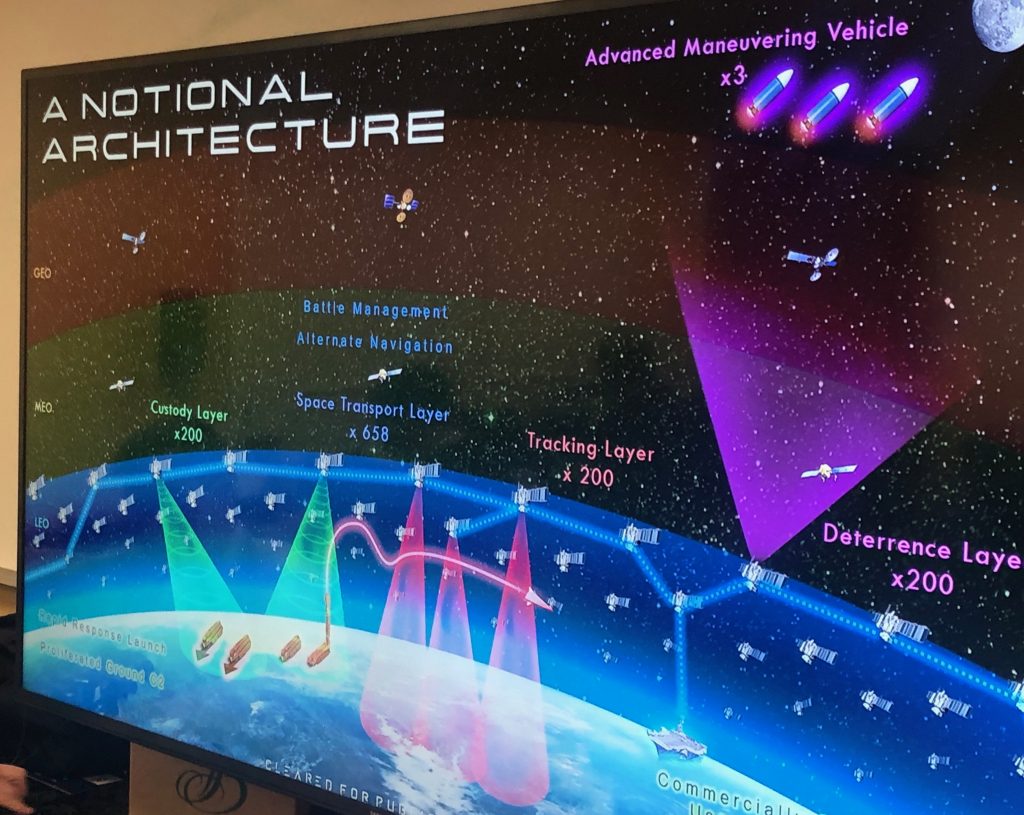
Space Development Agency notional space architecture
WASHINGTON: DoD wants a whopping $337 million — more than double last year’s tranche — in the 2021 budget for the Space Development Agency (SDA), despite continued uncertainty about what the DoD agency will do and with whom.
Congress appropriated a total of $125.3 million for SDA in 2020, a cut of about $25 million to the administration’s million request, reflecting skepticism about the agency’s plans and management.
In particular, Congress is worried about possible overlap between SDA, the Air Force’s Space and Missile Systems Center (SMC), the Space Rapid Capabilities Office (SpRCO) and the Missile Defense Agency.
Air Force Secretary Barbara Barrett is expected next month to report to Congress on how space acquisition will be organized under the new assistant Air Force Secretary for space acquisition and integration mandated in the 2020 National Defense Authorization Act (NDAA). That new assistant secretary was set up by Congress to oversee SDA, SMC, and SpRCO; and whoever holds that position will also become the acquisition executive for space systems and programs as of October 2022.
Most experts outside of DoD agree that, while the defense policy bill does not explicitly say so, its intent appears to be to shift all three the agencies to the Space Force. But Breaking D readers know there has been internal DoD disagreement about whether that is required.
DoD budget justification documents show $288.4 million for SDA research, development and test activities for 2021: $72.4 for advanced technology development; and $216 million for advanced component development and prototyping. For 2020, the administration had requested $150 million but Congress chopped that to $95 million. DoD requested another $48.2 for SDA in personnel and management funds; Congress allocated $30.3 million for 2020.
The jump in R&D funding reflects SDA’s ambitious plans to launch “dozens” of satellites by 2022 to create a skeleton architecture in Low Earth Orbit (LEO) to provide communications between satellites and ships, aircraft and ground-based weapon systems; track advanced missile threats including low-flying hypersonic cruise missiles; and to support targeting of adversary mobile ground systems.
Work toward that goal is slated to begin this year, with SDA Director Derek Tournear telling reporters Jan. 21 that requests for proposals for the data transport and tracking satellites will be issued in spring. This follows a Jan. 15 issued request for information (RFI) on optical communications links between satellites, and a broad area announcement (BAA) issued today seeking “leap-ahead” technologies across SDA’s planned LEO architecture of small(ish) satellites.
SDA’s end goal is to develop and deploy hundreds of small satellites under a seven-layer architecture that involves six different constellations and a ground system. According to the recent BAA, those seven layers are:
- Transport Layer to provide assured, resilient, low-latency military data and communications connectivity worldwide to the full range of warfighter platforms;
- Battle Management Layer to provide architecture tasking, mission command and control, and data dissemination to support time-sensitive kill chain closure at campaign scales; and
- Tracking Layer to provide global indications, warning, tracking, and targeting of advanced missile threats, including hypersonic missile systems;
- Custody Layer meant to provide 24×7, all-weather custody of time-sensitive, left-of-launch surface mobile targets (e.g., to support targeting for advanced missiles);
- Navigation Layer to provide alternate positioning, navigation, and timing (PNT) for Global Positioning System (GPS)-denied environments;
- Deterrence Layer, to deter hostile action in deep space (beyond Geosynchronous Earth Orbit (GEO) up to lunar distances);
- Support Layer to enable ground and launch segments to support a responsive space architecture.
Taking aim: Army leaders ponder mix of precision munitions vs conventional
Three four-star US Army generals this week weighed in with their opinions about finding the right balance between conventional and high-tech munitions – but the answers aren’t easy.


























